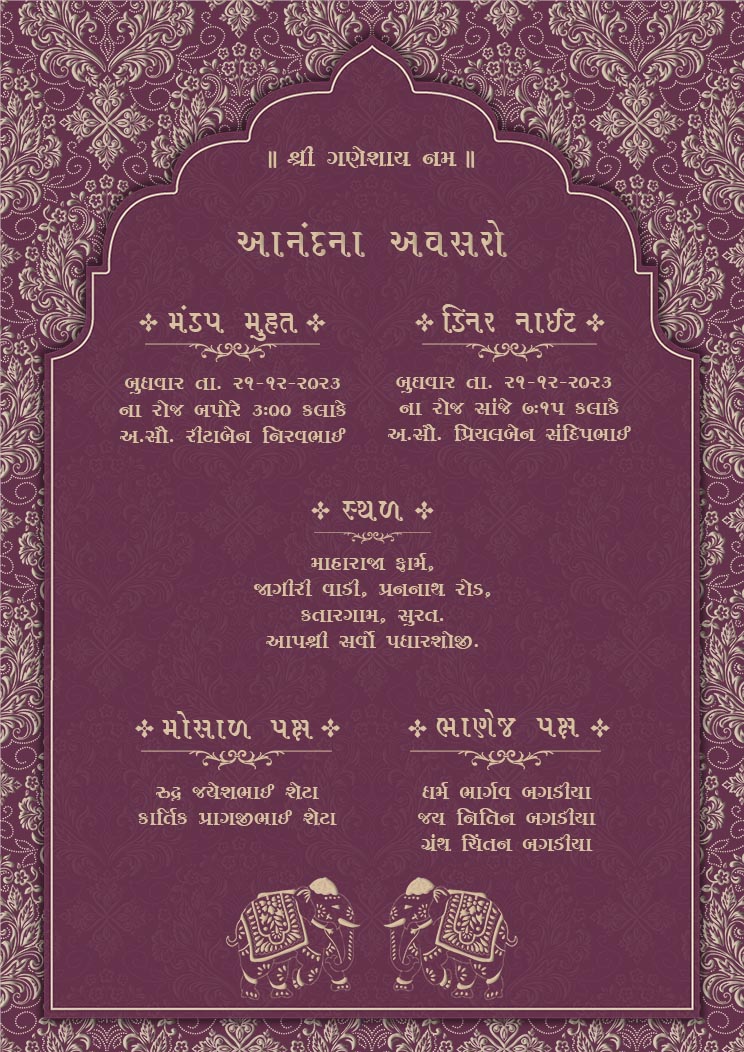
When it comes to the vibrant and culturally rich celebrations of a Gujarati wedding, every detail matters. Among the many components that contribute to the grandeur of such events, the Kankotri Gujarati Wedding Card holds a special place. The Kankotri, a traditional Gujarati wedding card, is not just an invitation; it’s a beautifully crafted piece of art that symbolizes the beginning of a joyous journey for the couple. In this article, we’ll explore the significance, design, and elements of Kankotri wedding cards, showcasing why they are so cherished in Gujarati culture.
The Significance of Kankotri
In Gujarati weddings, the Kankotri serves as the formal invitation to family and friends, marking the official announcement of the wedding. Traditionally, the Kankotri is presented in a grand manner, often accompanied by sweets and blessings. This practice underscores the importance of community and familial bonds in Gujarati culture. The card is typically sent out weeks in advance, giving guests ample time to prepare for the celebrations ahead.
The Kankotri also reflects the couple’s identity, with many families opting to personalize the card to showcase their heritage and values. From intricate designs to meaningful messages, each Kankotri tells a story of love, tradition, and cultural pride.
Elements of Kankotri Design
1. Artistry and Aesthetics
Kankotris are known for their exquisite designs that often feature traditional motifs and vibrant colors. Common design elements include:
- Peacocks and Flowers: Symbolizing beauty and love, these motifs are commonly used.
- Ganesha and Other Deities: Incorporating images of deities is a way to seek blessings for the couple’s future.
- Intricate Borders and Patterns: The borders are often adorned with traditional patterns that add to the overall elegance.
2. Materials and Formats
Kankotris are crafted using high-quality materials, ranging from textured paper to silk and even wood. The format can vary, but many families opt for a tri-fold or scroll-style invitation, allowing for more creativity in presentation. Some modern interpretations even incorporate laser-cut designs, adding a contemporary touch to traditional aesthetics.
3. Personalization
The ability to personalize a Kankotri makes it even more special. Couples often include their names in elaborate fonts, along with their respective family names. Some families also choose to add a personal message or quote that resonates with their journey, making each card unique.
The Content of the Kankotri
The content of a Kankotri is just as important as its design. A typical Kankotri includes the following elements:
1. The Invitation
The primary purpose of the Kankotri is to invite guests to the wedding. This section includes the names of the bride and groom, along with their families. It often opens with a traditional phrase, invoking blessings and good fortune.
2. Wedding Details
Critical details like the date, time, and venue of the wedding ceremonies are prominently displayed. This section is crucial for guests to plan their attendance.
3. Additional Events
Gujarati Invitation Card Maker are often multi-day affairs, featuring various ceremonies such as the Mehendi, Sangeet, and reception. The Kankotri may include details for these events, ensuring guests have all the information they need to celebrate with the couple.
4. Cultural Touchstones
Many Kankotris incorporate elements of Gujarati culture, such as proverbs or blessings in Gujarati script, adding depth and resonance to the invitation. This practice not only enriches the design but also connects the couple with their cultural roots.
The Evolution of Kankotri
While traditional Kankotris have a classic charm, the modern era has brought about changes in design and presentation. Many couples today are opting for eco-friendly materials and innovative designs that reflect their personal style. Digital invitations are also gaining popularity, providing a more contemporary approach to the traditional Kankotri.
Despite these changes, the essence of the Kankotri remains the same. It continues to serve as a heartfelt invitation, a symbol of love, and a representation of family values.
Conclusion
The Kankotri is more than just a wedding card; it’s a beautiful blend of tradition, art, and personal expression. As the couple embarks on their new journey together, the Kankotri stands as a cherished keepsake, a tangible reminder of the love and support of family and friends. Whether it’s a simple design or an elaborate one, each Kankotri tells a story—one that celebrates the rich tapestry of Gujarati culture and the joyous union of two lives.
In the world of Gujarati weddings, the Kankotri is an emblem of hope, love, and community, making it an indispensable part of the celebration. As couples continue to embrace this tradition, the Kankotri will undoubtedly remain a beloved aspect of Gujarati weddings for generations to come.